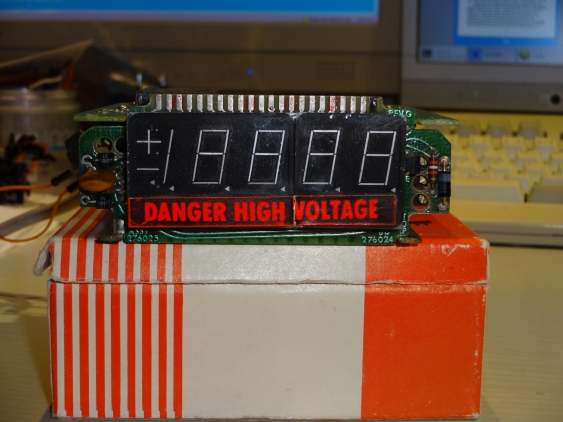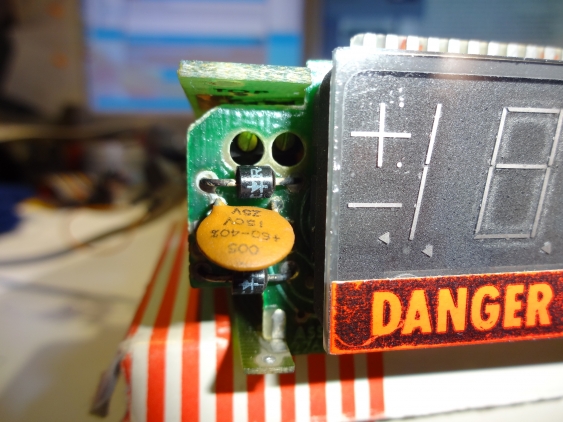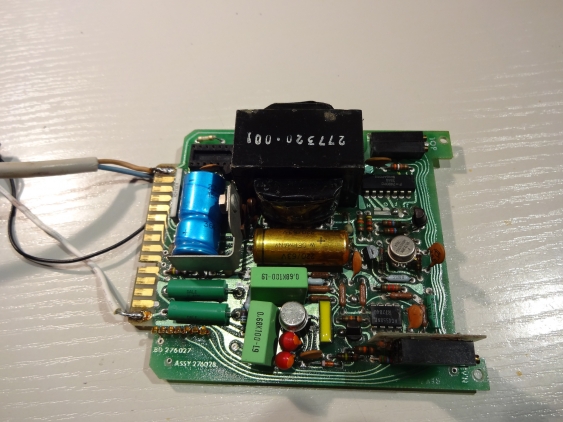« Reviving an old Weston 1234 digital panel meter
| Main |Old memories, old electronics kit and a new contest »
Calibrating an old Weston 1234 digital panel meter
So after reviving the display of my panel meter, I got stuck in my search for a manual. After a while, I started looking more deeply at all references I found and got lucky. Someone looking for a model 1230 manual got referenced to a model 1242 manual, and this one looked it was useful. Although its for a somewhat different model, it at least contained a schematic, some explanations for it and especially the steps needed for calibration.
When looking at the description, I saw that the Model 1242 only has four potentiometers, which matched to what I had already found out many years ago. Too bad the one potentiometer I struggled the most with was not there on the 1242 - I had labeled it as “gain overall / linearity”, and it seemed to affect basically anything.
Trimmers, so many trimmers
The trimmers can be found when removing the front, and are hidden behind some holes on the display board:
But after following the calibration steps, I found out that even though I was able to zero out the negative range, the positive range was still off. The 1242 manual said for that case “an internal calibration might be needed”. So I dug deeper into the circuit description, where the inner working are explained. The zeroing function in the 1242 has a digital management for differences between negative and positive range when zeroing out. So I tried to cancel out this difference with the one potentiometer being left - and yes, it worked!
So here is a close-up for all the potentiometer I need to fiddle around with:
And they all have a function
On the left side we have P1 (left one) and P2 (right one), whereas on the right side there are, from top to bottom, P3, P4 and P5. The right potentiometers are somewhat hidden behind the PCB, so I need to probe for them a little bit to use them. The functions of these trimmers are:
- P1: negative gain
- P2: positive gain
- P3: negative offset
- P4: positive offset (actually: difference between positive and negative offset)
- P5: zero point
Starting calibration
Given these functions, the steps for calibration are:
- short inputs, set offset with P5 - find the point where the sign switches from - to + (regardless of the displayed value)
- apply -20mV, set negative offset with P3 so that -20 is displayed
- apply +20mV, set positive offset with P4 so that 20 is displayed
- repeat steps 1 to 3 until all values are OK
- apply +10V, set positive gain with P2 so 10000 is displayed
- apply -10V, set negative gain with P1 so -10000 is displayed
Since I had no voltage reference for 10V, I used a 2.048V reference (build from a REF5020 which is hopefully good enough). Since the 20 mV voltage is not really for accuracy, but only for setting the zero offset, its accuracy is not as important. So I just used a voltage divider on my reference, which resulted in 18 mV output.
With that, I managed to set the zero point properly. But when setting the gain for the full range, I found out the trimming range of P1 and P2 was not enough to reach the value I needed. With the 2 V reference, I could get the measured value only to about 100 mV below the 2.048 V. And the trimmers were already down to 0 ohms, so I gould not even replace them with larger ones. The 1242 manual again called for an “internal calibration” in this case, so it looked like another roadblock. Bummer.
And there is always one more trimmer
When I got back to it the next day, took the board out of the enclosure (again) and took another deep look at the boards, I noticed that there is, in fact, a sixth potentiometer. It just is in another place - not at the front, but on the back, hidden under some wires:
And lo and behold, by turning it I was able to rapidly move the measured value (for both negative and positive range) up to were it belongs. Since this changed the zero offset too, I needed to go through the calibration steps again. After that I found that the changes to P6 were not enough - zeroing out affects also the full scale voltage. So I needed another two rounds of changing P6 and running the calibration. In the 1242 manual I cannot find any mention of another trimmer, but I guess it could be responsible for the reference current used for measuring.
Some PCB pictures
Last but not, here an image for the analog board, which I have not showed before:
See how crowded it is - one cannot really follow all the traces. I was not able to identify all the components on it, but by the date code on the ICs it looks like has been manufactured at latest in 1980. The two large green tubes on the bottom left are the resistors for the input divider - internally the meter has 200 mV full scale range. This is even exposed at the back, so I could use it. There are also other connection to the connector on the back, but I didn’t try to trace what they are used for - maybe they are used for proper calibration.
Next problem to solve is that the zero point drift a lot during warm-up. When switching it on, I usually get a reading of 15 mV. Over the course of one hour, it goes down to nearly zero. I think this is due to the large heating of the transformer. So maybe I could add a fan to keep the temperature drift of the whole system, and especially the reference, in a tighter range.
As a reference (and in case the BAMA website goes down), here is a local copy of the Weston 1242 manual.




